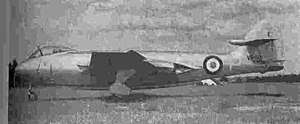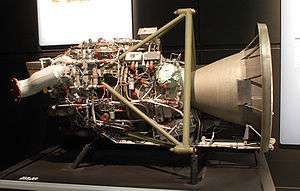Armstrong Siddeley Snarler
| Country of origin | United Kingdom |
|---|---|
| Manufacturer | Armstrong Siddeley |
| Liquid-fuel engine | |
| Propellant | Liquid oxygen (LOX) / methanol/water |
| Pumps | Centrifugal, mechanically driven by external shaft drive from other engine. |
| Performance | |
| Thrust | 2,000 lbf (8.9 kN) [1] |
| Propellant capacity |
LOX 75 imperial gallons (340 L), water-methanol 120 imperial gallons (550 L) |
The Armstrong Siddeley ASSn. Snarler was a small rocket engine used for mixed-power experiments with an early turbojet engine[2][3] and was the first British liquid-fuelled rocket engine to fly[4] Unlike other British rocket engine projects that used hydrogen peroxide as an oxidiser, Armstrong Siddeley's used liquid oxygen. The rocket engine is described as having a dry weight of 215 lbf (960 N) thrust of 2,000 lbf (8.9 kN) and a specific fuel consumption of 20 (lb/h)/lbf thrust.[4] Work began in 1947 and the final configuration was first tested on 29 March 1950.[5]
The prototype of the Hawker P.1040 Sea Hawk, VP 401, had a Snarler rocket of 2,000 lbf thrust added in its tail. The Rolls-Royce Nene turbojet, of 5,200 lbf thrust, had a split tailpipe which exhausted either side of the fuselage. The combination was termed the Hawker P.1072.[5][6] This gave approximately[7] 50% greater thrust, although with twenty times the fuel consumption.[4] It was first used in flight on 20 November 1950, by Hawker's test pilot Trevor "Wimpy" Wade.[3] Half a dozen flights were made using the rocket motor before a minor explosion damaged the aircraft. Although methanol was used in the P.1072, jet fuel could be used for the Snarler. It was decided that reheat was a more practical proposition for boosting jet thrust than rockets.
An unusual feature of the engine was that the fuel/oxidiser pump was externally driven, by a drive from the gearbox of the P.1072's turbojet engine.[8] This feature continued into the first versions of the subsequent Screamer engine, but was later replaced with a turbine-driven turbopump.
Variants
- ASSn.1 Snarler
- The prototype and test engines, (given the Ministry of Supply designation ASSn.).
References
- ↑ "United Kingdom Aerospace and Weapons Projects: Rocket Engines". Skomer. Archived from the original on 2008-04-22.
- ↑ S. Allen (7 Dec 1951). "Rockets for Aircraft Propulsion". The Aeroplane.
- 1 2 "Snarler" (PDF). Flight: 92–93. 25 July 1952.
- 1 2 3 "Aero engines 1954" (PDF). Flight: 447–448 (Armstrong Siddeley Snarler ASSn.1). 6 August 1954. (includes external line drawing)
- 1 2 "Armstrong Siddeley Snarler" (PDF). Flight: 176–180. 6 August 1954.
- ↑ "The Quest for Power..." (PDF). Flight: 444 (P.1072 Armstrong Siddeley Snarler ASSn.1). 6 August 1954.
Transferring liquid oxygen from a B.O.C. spherical tanker to the Hawker P.1072 in which the Sn rocket was tested. The gas is exhausting through the lower vents and rapidly evaporating.
(P.1072 being fuelled) - ↑ Although the Nene's thrust, as for any turbojet, fell with increasing altitude the Snarler's remained constant.
- ↑ "Armstrong Siddeley Screamer" (PDF). Flight: 160–164. 27 July 1956. (not publicly known at the time of Flight, 1954)

